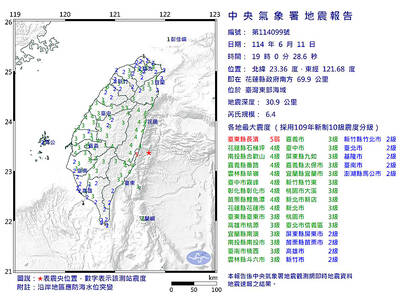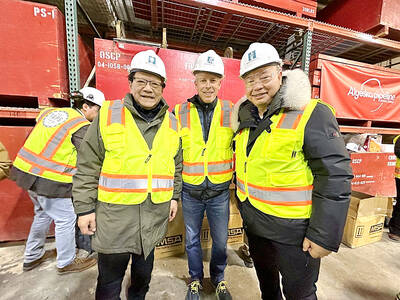The first set of tilting trains arrived at the port of Keelung from Japan yesterday morning. The trains are to be used to serve passengers on the East Coast Line after three months of testing.
The new tilting train, named the “Puyuma Express,” is scheduled to be operational before the Lunar New Year holiday next year.
“Puyuma” means “united” in the language of Taitung County’s tribe of the same name. The name was chosen after the Taitung County Government and the Taiwan Railway Administration (TRA) launched a contest to name the new train.
The 16 train cars that arrived yesterday drew the attention of railway enthusiasts, who had waited at the pier before the ship arrived to capture the historic moment with their cameras.
The body of the new train car is mainly white, with red lines on the side of the car, as well as on the front of the locomotive. The red lines symbolize the totems of the nation’s Aboriginal tribes.
The railway service’s brand “TRA” is presented in cursive writing on the side of the train.
TRA Director-General Frank Fan (范植谷) said the new tilting train was built using an aluminum alloy and is equipped with seats that allow passengers to sit face-to-face, with a table in between them. Mothers and disabled passengers can access nursery rooms and multiple-use toilets on the trains.
Fan said the remaining 120 train cars are scheduled to be delivered by the end of next year. They could all be used to transport passengers during the Lunar New Year holiday in 2014, he said.
The TRA said the Puyuma Express could reach a maximum operating speed of 150kph, which would make it faster than the Taroko Express, the TRA’s existing tilting-train service.
With more new tilting trains and the electrification of the East Coast Line, the administration estimates that the line’s capacity will greatly expand in 2014, adding that the number of trains services to Hualien and Taitung could increase by more than 10 a day.

A magnitude 6.4 earthquake struck off the coast of Hualien County in eastern Taiwan at 7pm yesterday, the Central Weather Administration (CWA) said. The epicenter of the temblor was at sea, about 69.9km south of Hualien County Hall, at a depth of 30.9km, it said. There were no immediate reports of damage resulting from the quake. The earthquake’s intensity, which gauges the actual effect of a temblor, was highest in Taitung County’s Changbin Township (長濱), where it measured 5 on Taiwan’s seven-tier intensity scale. The quake also measured an intensity of 4 in Hualien, Nantou, Chiayi, Yunlin, Changhua and Miaoli counties, as well as

Credit departments of farmers’ and fishers’ associations blocked a total of more than NT$180 million (US$6.01 million) from being lost to scams last year, National Police Agency (NPA) data showed. The Agricultural Finance Agency (AFA) said last week that staff of farmers’ and fishers’ associations’ credit departments are required to implement fraud prevention measures when they serve clients at the counter. They would ask clients about personal financial management activities whenever they suspect there might be a fraud situation, and would immediately report the incident to local authorities, which would send police officers to the site to help, it said. NPA data showed

ENERGY RESILIENCE: Although Alaska is open for investments, Taiwan is sourcing its gas from the Middle East, and the sea routes carry risks, Ho Cheng-hui said US government officials’ high-profile reception of a Taiwanese representative at the Alaska Sustainable Energy Conference indicated the emergence of an Indo-Pacific energy resilience alliance, an academic said. Presidential Office Secretary-General Pan Men-an (潘孟安) attended the conference in Alaska on Thursday last week at the invitation of the US government. Pan visited oil and gas facilities with senior US officials, including US Secretary of the Interior Doug Burgum, US Secretary of Energy Chris Wright, Alaska Governor Mike Dunleavy and US Senator Daniel Sullivan. Pan attending the conference on behalf of President William Lai (賴清德) shows a significant elevation in diplomatic representation,

The Taipei City Reserve Command yesterday initiated its first-ever 14-day recall of some of the city’s civilian service reservists, who are to undergo additional training on top of refresher courses. The command said that it rented sites in Neihu District (內湖), including the Taipei Tennis Center, for the duration of the camp to optimize tactical positioning and accommodate the size of the battalion of reservists. A battalion is made up of four companies of more than 200 reservists each, it said. Aside from shooting drills at a range in New Taipei City’s Linkou District (林口), the remainder of the training would be at